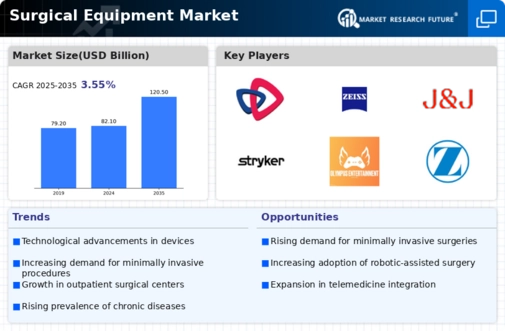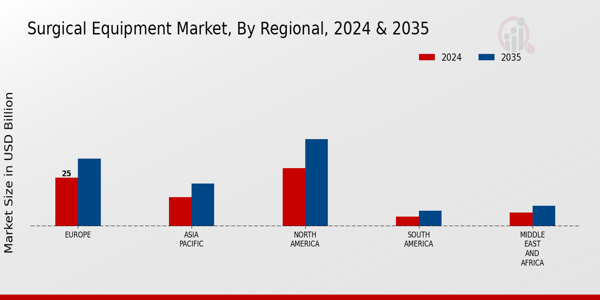Increasing Prevalence of Chronic Diseases
The Surgical Equipment Market is also being propelled by the rising prevalence of chronic diseases, which necessitate surgical interventions. Conditions such as cardiovascular diseases, diabetes, and obesity are on the rise, leading to an increased demand for surgical procedures. According to health statistics, the number of surgical procedures performed annually is expected to increase by 5% over the next few years, driven by the need for effective treatment options. This surge in surgical demand is prompting healthcare providers to invest in advanced surgical equipment to improve patient outcomes. As a result, the Surgical Equipment Market is likely to expand, with manufacturers focusing on developing innovative solutions tailored to address the complexities of chronic disease management.
Focus on Patient Safety and Quality of Care
The Surgical Equipment Market is increasingly prioritizing patient safety and quality of care, which is driving the demand for advanced surgical tools. Regulatory bodies and healthcare organizations are emphasizing the importance of safety standards and protocols in surgical procedures. This focus has led to the development of equipment that minimizes risks associated with surgeries, such as infection control and precision in surgical techniques. Data indicates that hospitals investing in high-quality surgical equipment experience lower complication rates and improved patient satisfaction scores. As healthcare providers strive to enhance the quality of care, the Surgical Equipment Market is likely to see a rise in demand for innovative solutions that align with these safety standards, ultimately fostering a culture of excellence in surgical practices.
Growing Investment in Healthcare Infrastructure
The Surgical Equipment Market is benefiting from the growing investment in healthcare infrastructure across various regions. Governments and private entities are increasingly allocating funds to enhance healthcare facilities, which includes upgrading surgical equipment. This trend is particularly evident in emerging economies, where the establishment of new hospitals and surgical centers is on the rise. Recent reports indicate that healthcare spending is projected to increase by 7% annually, with a significant portion directed towards surgical equipment procurement. As healthcare facilities modernize their infrastructure, the demand for advanced surgical tools and technologies is expected to surge. This investment not only improves surgical outcomes but also positions the Surgical Equipment Market for sustained growth in the foreseeable future.
Rising Demand for Minimally Invasive Procedures
The Surgical Equipment Market is significantly influenced by the increasing demand for minimally invasive procedures. Patients and healthcare providers alike are gravitating towards techniques that promise reduced trauma, shorter recovery times, and less postoperative pain. This trend is reflected in the growing utilization of laparoscopic and endoscopic surgeries, which have become standard practices in various medical fields. Data suggests that the minimally invasive surgery market is expected to grow at a compound annual growth rate of over 10% in the coming years. As surgical equipment evolves to support these procedures, manufacturers are focusing on developing specialized instruments that enhance the effectiveness of minimally invasive techniques. Consequently, this shift is likely to propel the Surgical Equipment Market forward, as more healthcare facilities invest in advanced surgical tools.
Technological Advancements in Surgical Equipment
The Surgical Equipment Market is experiencing a notable transformation driven by rapid technological advancements. Innovations such as robotic-assisted surgery, advanced imaging systems, and smart surgical instruments are enhancing precision and efficiency in surgical procedures. For instance, the integration of artificial intelligence in surgical tools is expected to improve decision-making and patient outcomes. According to recent data, the market for robotic surgical systems is projected to reach USD 20 billion by 2026, indicating a robust growth trajectory. These advancements not only facilitate minimally invasive surgeries but also reduce recovery times, thereby increasing patient satisfaction. As hospitals and surgical centers adopt these cutting-edge technologies, the Surgical Equipment Market is likely to witness significant expansion.






















Leave a Comment